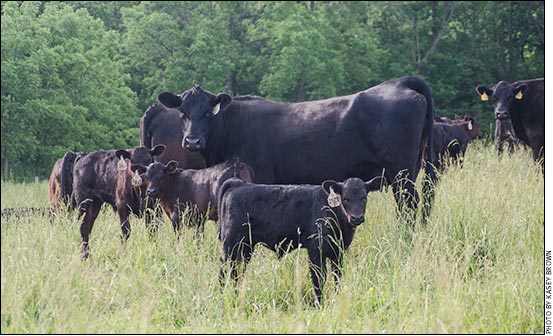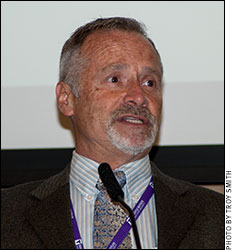
Managing Maternal Separation
Managing behavior during weaning increases performance
of calves and cows later.
“There is no event that we impose upon cattle that is more stressful than weaning. Looking at behavior is in our toolbox to evaluate welfare,” said Joe Stookey, professor of animal behavior in the Western College of Veterinary Medicine at the University of Saskatchewan. He spoke at the fifth International Symposium on Beef Cattle Welfare (ISBCW) in Manhattan, Kan., June 8-10.

“There is no event that we impose upon cattle that is more stressful than weaning. Looking at behavior is in our toolbox to evaluate welfare,” said Joe Stookey.
Weaning creates an immunocompromised calf, so more calves are treated for health reasons immediately postweaning than at any other time in their lives. A behavioral sign of stress at weaning is calling, both by calves and cows. This is out of character, per se, because calling is a risky behavior for a prey animal, Stookey noted. Weaning stress also causes a noticeable setback in gain.
“I wish we could change shipping fever’s name to weaning fever, which is really what it is,” said Stookey. He shared research on the effect of weaning stress on disease susceptibility. Forty percent of the preweaned calves prior to feedlot shipment experienced sickness three to four days after, while 80% of the calves abruptly weaned at transport got sick. Preconditioning delayed the onset and frequency of sickness.
The issue with preconditioning is that producers rarely have an economic incentive to do it, he admitted. It helps feedlot health and gain rates, though if cattlemen sell their calves at weaning, they get little profit from increased welfare later in the system.
Stookey shared survey data in which 50% of cattle producers send their calves to market on the same day as weaning. Additionally, about 60% of the respondents never vaccinated their calves for respiratory disease. He said the general response to these was, “No one pays us to do that,” to which he responded that it is just responsible beef production to vaccinate calves. That in itself can cut down on antibiotic use and need.
Separation anxiety
There are many stressors that go with traditional weaning: age at weaning, new social environment, physical separation, premature end of lactation, transport, new location and a new diet. Which of these is the most prominent?
He shared some research that showed fenceline weaning reduced calling by both cows and calves by about one-third, reduced walking, and increased lying down time and performance. The process is not perfect, and it requires good fences, but the cows and calves being able to see each other is better than being apart.
Another study looked at whether the overarching issue of weaning stress was the stopping of milk or the separation. The idea of weaning in nature is mutually agreed upon, and the milk stops, Stookey explained. The study used nose flaps on the calves to stop the access of milk about a week before separation, called two-stage weaning. The research team learned that the separation was the culprit; the milk loss was not.
While the calves still exhibited fence walking, calling and reduced eating, each was considerably less than the control group of abruptly weaned calves. The abruptly weaned calves walked 15 additional miles. With increased walking, increased calling and much less eating, it’s no wonder abruptly weaned calves get sick, he added.
It is possible to leave nose flaps in too long, however. Three to seven days is ideal, because some calves can learn to cheat if they are left in longer. Additionally, the longer the nose flap is in, the looser and sloppier the flap gets. He adds that two-stage weaning allows for “truck weaning” without the adverse effects of abrupt weaning.
Watch for additional coverage of the 2016 ISBCW on www.angus.media and in the Angus Journal and Angus Beef Bulletin. Comprehensive meeting coverage will be archived at www.api-virtuallibrary.com/meetings_other_news.html.







